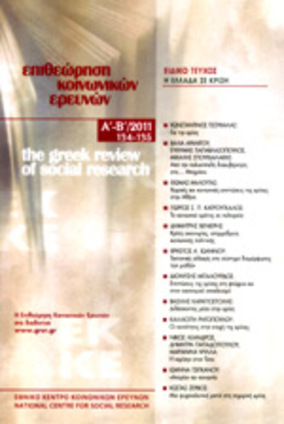Dis-placing the world : Nomadic politics in Mona Hatoum’s living cartographies of passages
Part of : Επιθεώρηση κοινωνικών ερευνών ; Vol.140/141, 2013, pages 169-184
Issue:
Pages:
169-184
Parallel Title:
Εκ-τοπίζοντας τον κόσμο : Νομαδική πολιτική στις βιωματικές χαρτογραφίες περασμάτων της Mona Hatoum
Section Title:
Articles
Author:
Abstract:
The present essay draws from contemporary art and particularly from the art of the diasporic artist Mona Hatoum. Hers is an art about a corporeal subjectivity attuned to a living cartography of passages between Palestine, Lebanon, and England. I explore her art work with intersecting cartographies and corporealities, by focusing on her artistic gestures of displacing established notions of “home” and the “world”, in all their gendered implications. I try to unravel the ways in which Mona Hatoum keeps us on the alert for the hierarchies of false and abstract universalism, while, at the same time, keeps open the promise (and the question) for the potential subversiveness of “foreignness” and “belonging”.
Subject:
Subject (LC):
Keywords:
Nomadic politics, postcolonial and feminist art, embodied political subjectivities, νομαδική πολιτική μετααποικιακή και φεμινιστική τέχνη, ενσώματες πολιτικές υποκειμενικότητες
Electronic Resources:
References (1):
- Ahmed S., Castaneda C., Fortier A.M., Sheller M., 2003, Uprootings/regroundings, Oxford, Berg. Ankori G., 2003, «“Dis-Orientalisms”: Displaced bodies/embodied displacements in contemporary Palestinian art», in S. Ahmed, C. Castaned, A.M. Fortier, and M. Sheller (eds), Uprootings/regroundings, Oxford, Berg, pp. 59-90. Bhabha H., 2006, «Another country», in F. Daftari (ed.), Without boundary, New York, The Museum of Modern Art, pp. 30-35. --, 1994, The location of culture, New York, NY, Routledge. Bhabha H., McCarthy R., Sikander S., 2001, «Miniaturizing Modernity: Shahzia Sikander in conversation with Homi Bhabha», in G. D. Parameshwar (ed.), Alternative modernities, NC, Duke University Press, pp. 165-171. Braidotti R., 2011, 2nd edition, Nomadic subjects: Embodiment and sexual difference in contemporary feminist theory, New York, NY, Columbia University Press. Brown W., 2010, Walled states, waning sovereignty, New York, NY, Zone Books. Butler J., 2012, Parting ways: Jewishness and the critique of Zionism, New York, NY, Columbia University Press. --, 2005, Giving an account of oneself, New York, NY, Fordham University Press. Du Bois W.E.B, 2007, The souls of black folk, Oxford, Oxford University Press. Hatoum M., 2000, Mona Hatoum: The entire world as a foreign land, London, Tate Gallery. Khana R., 2009, «Technologies of belonging: Sensus communis, disidentification», in B. Hinderliter, W. Kaizen, V. Maimon, J. Mansoor, and S. McCormick (eds), Communities of sense: rethinking aesthetics and politics, Durham, NC, Duke University Press, pp. 111-132. Kristeva J., 1982, Powers of horror: An essay on abjection, New York, NY, Columbia University Press. Mansoor J., 2010, «A spectral universality: Mona Hatoum’s biopolitics of abstraction», October, 133, pp. 49-74. Mitchell W.J.T., 2012, Seeing through race, Cambridge, Massachusetts, Harvard University Press. Nancy J.L., 2008, Corpus, New York, NY, Fordham University Press. Said E., 2002, Reflections on exile and other essays, Cambridge, Massachusetts, Harvard University Press. --, 2000, «The art of displacement: Mona Hatoum’s logic of irreconcilables», in Mona Hatoum: The entire world as a foreign land, London, Tate Gallery, pp. 7-17. Wagstaff S., 2000, «Uncharted Territory: New Perspectives in the art of Mona Hatoum», in Mona Hatoum: The entire world as a foreign land, London, Tate Gallery, pp. 27-41.




